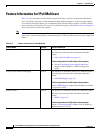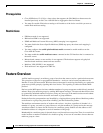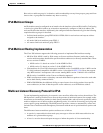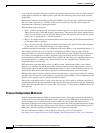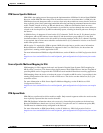
42-5
Cisco ASR 901 Series Aggregation Services Router Software Configuration Guide
OL-23826-09
Chapter 42 IPv6 Multicast
Feature Overview
PIM Source Specific Multicast
PIM SSM is the routing protocol that supports the implementation of SSM and is derived from PIM SM.
However, unlike PIM SM where data from all multicast sources are sent when there is a PIM join, the
SSM feature forwards datagram traffic to receivers from only those multicast sources that the receivers
have explicitly joined, thus optimizing bandwidth utilization and denying unwanted Internet broadcast
traffic. Further, instead of the use of RP and shared trees, SSM uses information found on source
addresses for a multicast group. This information is provided by receivers through the source addresses
relayed to the last-hop devices by MLD membership reports, resulting in shortest-path trees directly to
the sources.
In SSM, delivery of datagrams is based on the (S, G) channels. Traffic for one (S, G) channel consists
of datagrams with an IPv6 unicast source address S and the multicast group address G as the IPv6
destination address. Systems receive this traffic by becoming members of the (S, G) channel. Signaling
is not required, but receivers must subscribe or unsubscribe to (S, G) channels to receive or not receive
traffic from specific sources.
MLD version 2 is required for SSM to operate. MLD allows the host to provide source information.
Before SSM runs with MLD, SSM must be supported in the Cisco IPv6 device, the host where the
application is running, and the application itself.
For more information on PIM Source-Specific Multicast, see the IP Multicast: PIM Configuration Guide
at:
http://www.cisco.com/en/US/docs/ios-xml/ios/ipmulti_pim/configuration/xe-3s/ip6-mcast-pim-ssm.ht
ml
Source Specific Multicast Mapping for IPv6
SSM mapping for IPv6 supports both static and dynamic Domain Name System (DNS) mapping for
MLD version 1 receivers. This feature allows deployment of IPv6 SSM with hosts that are incapable of
providing MLD version 2 support in their TCP/IP host stack and their IP multicast receiving application.
SSM mapping allows the device to look up the source of a multicast MLD version 1 report either in the
running configuration of the device or from a DNS server. The device can then initiate an (S, G) join
toward the source.
For more information on IPv6 Source Specific Multicast Mapping, see the IP Multicast: PIM
Configuration Guide at:
http://www.cisco.com/en/US/docs/ios-xml/ios/ipmulti_pim/configuration/xe-3s/ip6-mcast-ssm-map.ht
ml
PIM-Sparse Mode
PIM-SM uses a pull model to deliver multicast traffic. Only network segments with active receivers that
have explicitly requested the data receive the traffic.
PIM-SM distributes information about active sources by forwarding data packets on the shared tree.
Because PIM-SM uses shared trees (at least, initially), it requires the use of a rendezvous point (RP).
The RP must be administratively configured in the network.
For more information on PIM Sparse Mode, see the IP Multicast: PIM Configuration Guide at:
http://www.cisco.com/en/US/docs/ios-xml/ios/ipmulti_pim/configuration/xe-3s/ip6-mcast-pim-sm.htm
l




